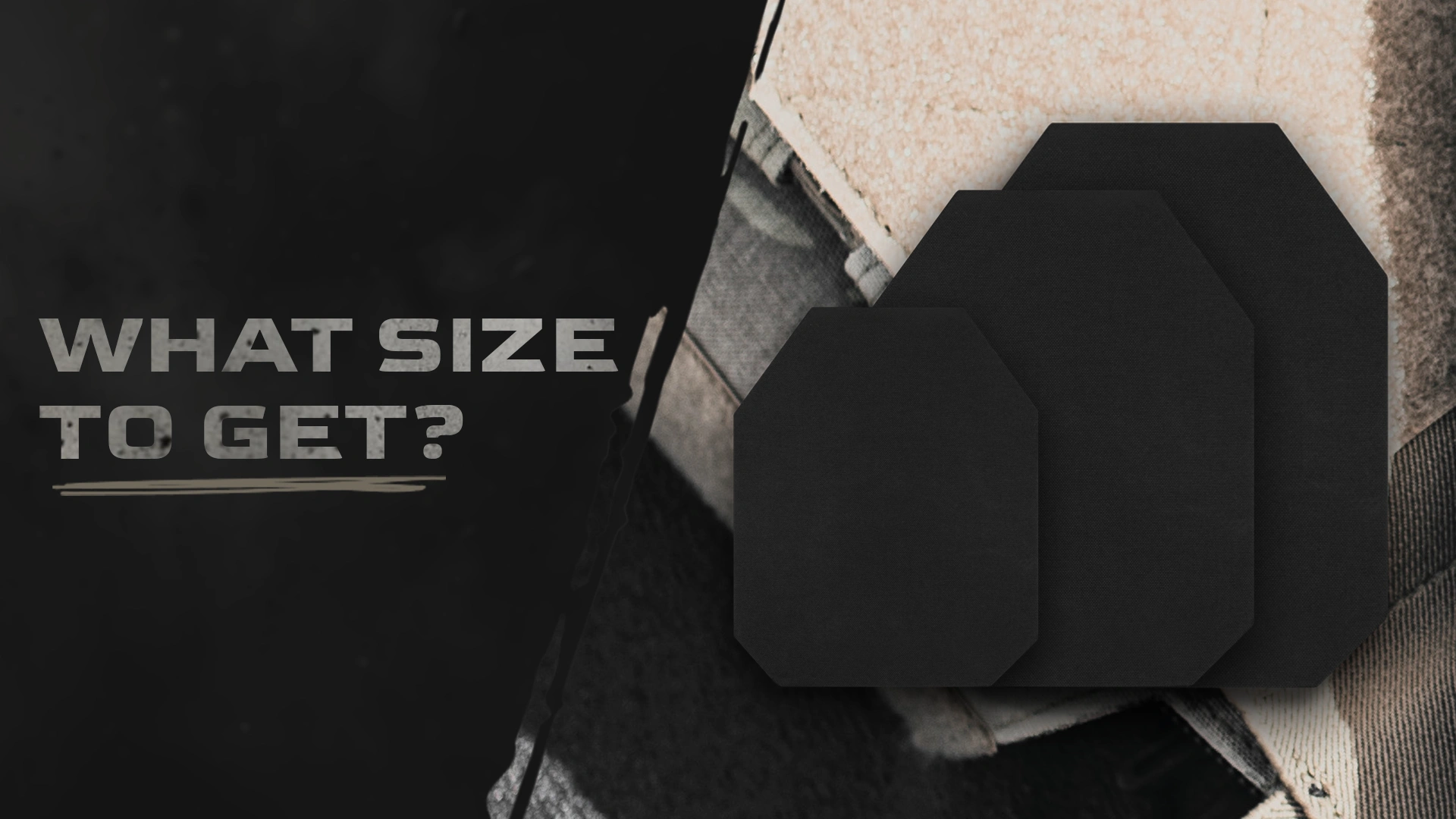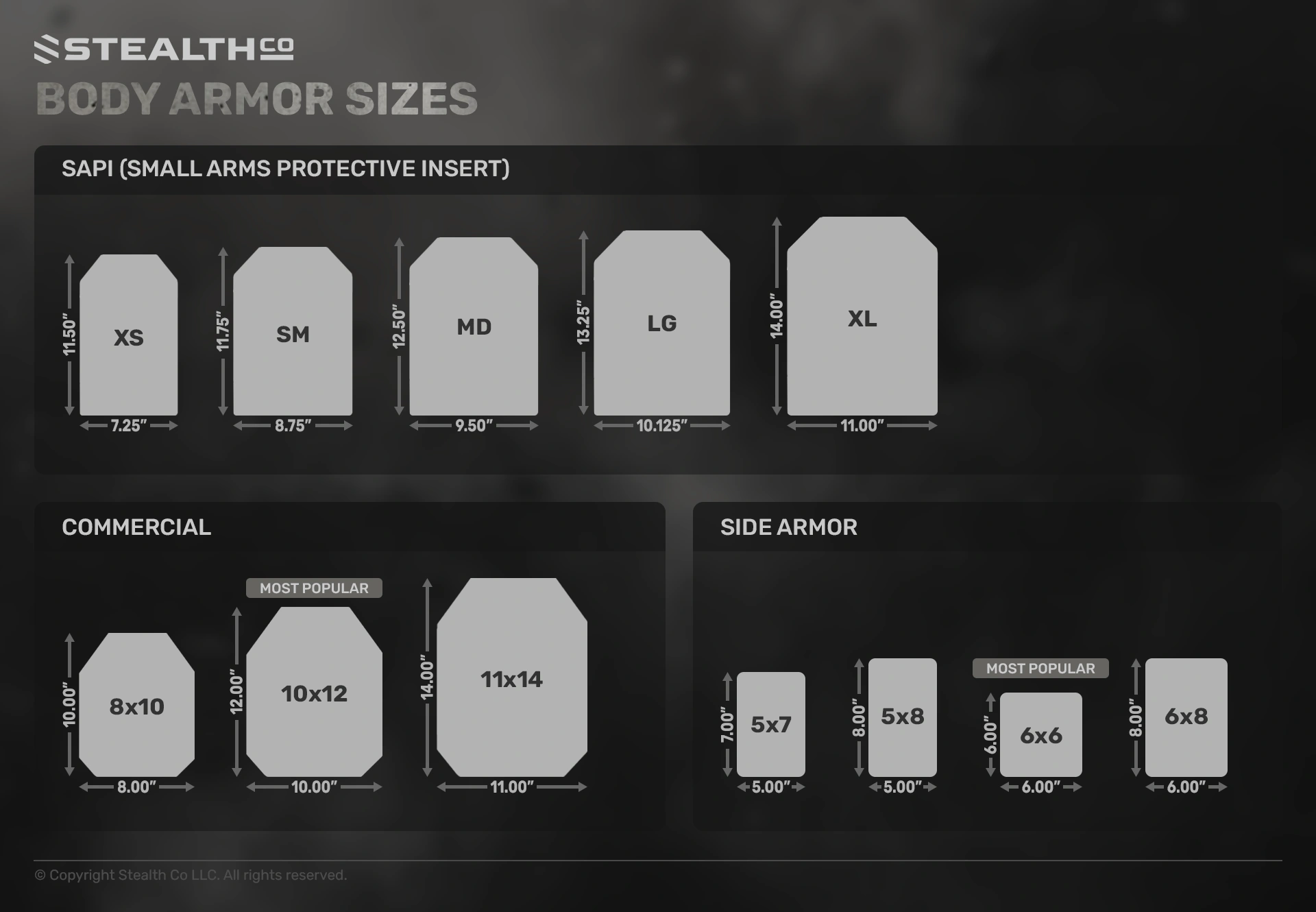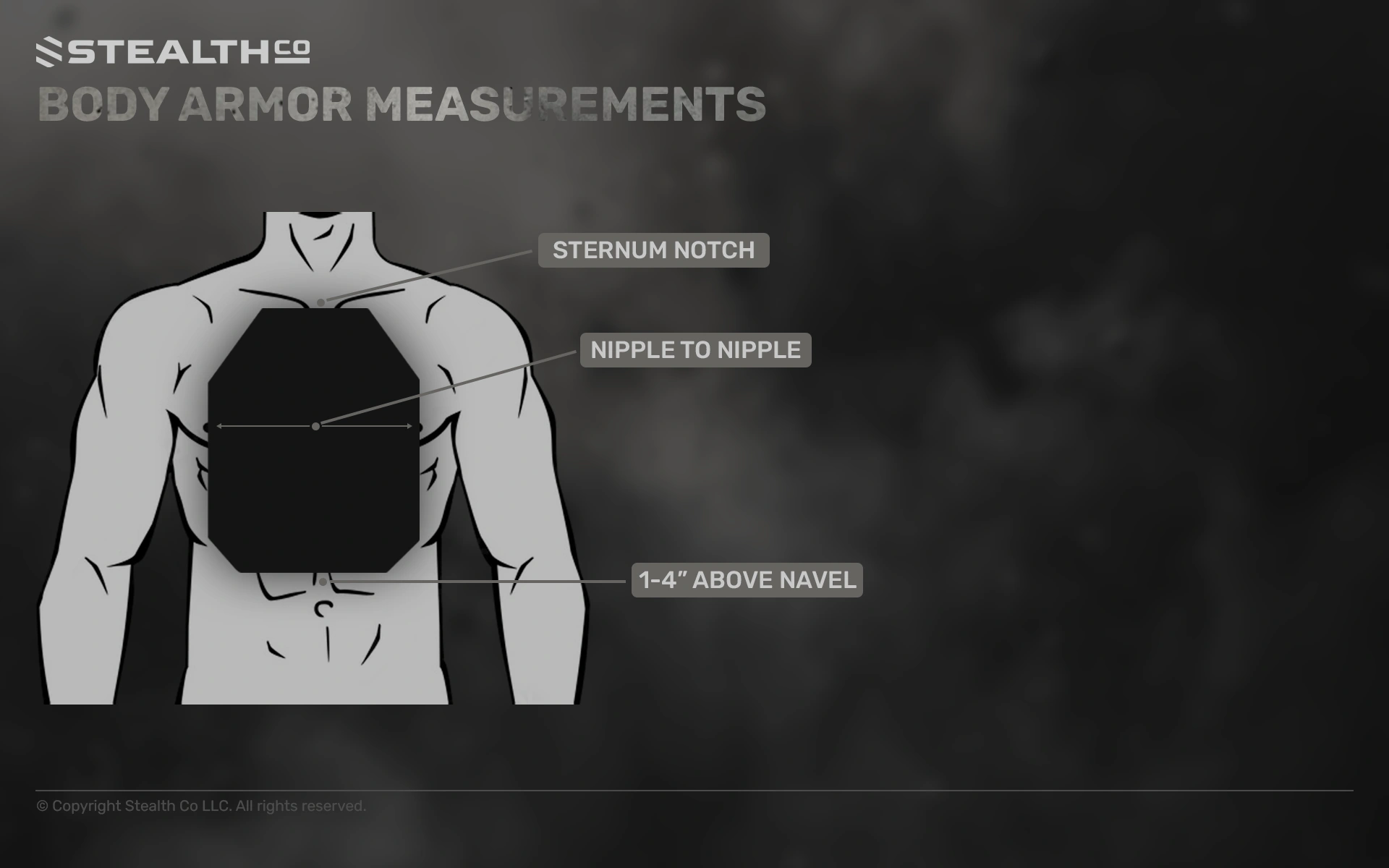
1. Introduction: Why Body Armor Sizing Matters
Hard armor plates, typically constructed from ceramic composites, advanced polyethylene, or specialized steel alloys, represent a critical element of personal protection against rifle threats. Unlike soft armor, which is primarily designed to defeat handgun rounds and fragmentation, hard plates are engineered to protect the vital organs housed within the torso’s upper thoracic cavity, often referred to as the “cardiac box”. However, the effectiveness of any hard armor plate hinges critically on selecting the correct size.
A fundamental misunderstanding often arises regarding body armor sizing: it does not correlate with standard clothing sizes like T-shirts. The objective is not to cover the entire torso proportionally, but rather to shield specific vital anatomical structures while permitting essential freedom of movement. This distinction is crucial because relying on clothing size as a proxy for armor size is a common mistake that can lead to dangerously improper fit. Such errors occur because armor must conform to the relatively fixed dimensions of the vital organs and rib cage, which do not scale directly with overall body size or adiposity in the way clothing does.
Achieving a proper fit is therefore paramount, influencing both the armor’s protective capabilities and the user’s ability to function effectively. An improperly sized plate can result in inadequate coverage, leaving vital areas exposed, or it can shift during movement, creating dangerous gaps in protection. Conversely, a plate that is too large can severely restrict mobility, interfere with the ability to properly shoulder a rifle or present a handgun, cause discomfort or injury when sitting or bending, and contribute to premature fatigue due to excess weight and bulk.
This inherent tension between maximizing protective coverage and maintaining necessary mobility represents the central challenge in armor selection. Armor inevitably adds weight and bulk, which can impede physical performance. The goal is not simply to wear the largest plate possible, but to find the optimal balance: a plate large enough to cover the vital zone but sized and shaped to minimize the penalty on movement essential for tactical responses, such as seeking cover or returning fire effectively. Therefore, understanding standard sizing conventions and accurate self-measurement techniques is essential for making an informed decision that enhances, rather than compromises, personal safety.
2. Body Armor Plate Sizes
The body armor market utilizes two primary sizing paradigms: the standardized military SAPI system and common commercial dimensions. Understanding both is key to navigating available options.

2.1 SAPI Sizes
SAPI, an acronym for Small Arms Protective Insert, refers to the standard hard armor plates utilized by the United States military. These plates are designed with specific dimensions and shapes to fit into standard-issue plate carriers. An evolution of this standard is ESAPI (Enhanced SAPI), which offers protection against higher-level threats; ESAPI plates maintain the same dimensions as their SAPI counterparts but are typically heavier due to denser materials.
The SAPI system employs a range of sizes based on anthropometric data to ensure proper fit across diverse military personnel. The standard front/back plate sizes are:
| Size | Width | Height |
| Extra Small | 7.25″ | 11.50″ |
| Small | 8.75″ | 11.75″ |
| Medium | 9.50″ | 12.50″ |
| Large | 10.125″ | 13.25″ |
| Extra Large | 11.00″ | 14.00″ |
The Medium SAPI size (9.5″ x 12.5″) is often cited as the most common, designed to fit a significant majority (up to the 95th percentile mentioned in one source) of military users. In addition to front and back plates, the SAPI system includes standardized side plates (S-SAPI or the enhanced ESBI – Enhanced Side Ballistic Insert) for lateral torso protection, commonly measuring 6″ x 6″, 6″ x 8″, or 7″ x 8″.
2.2 Commercial Sizes
Outside of military procurement, the commercial body armor market predominantly features a simplified set of nominal sizes. These sizes are widely available from numerous armor manufacturers.
| Size | Typical Width | Typical Height |
| 8×10 | 8.00″ | 10.00″ |
| 10×12 | 10.00″ | 12.00″ |
| 11×14 | 11.00″ | 14.00″ |
The 10″ x 12″ plate is frequently marketed as a “one size fits most” or “middle of the road” option, intended to provide adequate vital organ coverage for a large percentage of the adult population. The 8″ x 10″ size is generally recommended for individuals with smaller or shorter torsos, often including many females. Conversely, the 11″ x 14″ size caters to larger or taller individuals requiring more coverage.
2.3 SAPI vs. Commercial Plates: Understanding the Differences
The core difference lies in the sizing philosophy. The SAPI system uses multiple, precisely defined sizes derived from military anthropometric data to achieve a tailored fit across a large, diverse population. The commercial market often simplifies this into fewer, broader categories, with the 10×12 size embodying the “one-size-fits-most” strategy aimed at maximizing compatibility and reducing inventory complexity.
While dimensionally similar, it’s important to note that a Medium SAPI (9.5″ x 12.5″) is not identical to a commercial 10″ x 12″. This half-inch difference in both width and height can affect how snugly the plate fits within a plate carrier designed for one specific standard. However, many commercial manufacturers do offer plates cut to exact SAPI dimensions (Small, Medium, Large, XL) alongside their nominal 10×12 offerings.
Beyond dimensions, the shape or “cut” of the plate significantly impacts fit and function.
- SAPI Cut: The standard military profile is roughly rectangular with the top corners angled or clipped symmetrically (often around 45 degrees) and typically features rounded corners. This design balances coverage with some allowance for arm movement.
- Shooter’s Cut: This is a common commercial variation characterized by more aggressively angled or cut-away upper corners compared to the SAPI cut. The primary goal is to remove material from the shoulder pocket area, facilitating easier and more comfortable shouldering of a rifle stock and potentially increasing arm mobility. Some shooter’s cuts also feature tapered bottom corners for additional weight savings and mobility.
- Swimmer’s Cut: This cut features even more material removed from the upper sides/shoulders than a shooter’s cut, maximizing range of motion, particularly for overhead arm movements. This enhanced mobility comes at the cost of reduced upper chest and shoulder coverage.
These different cuts directly reflect the fundamental trade-off between protection and mobility. The SAPI cut generally prioritizes maximizing coverage area, while Shooter’s and Swimmer’s cuts deliberately sacrifice some coverage to enhance freedom of movement, particularly for dynamic weapon manipulation.
Crucially, unlike the standardized SAPI dimensions and shape, there is no official standard for what constitutes a “Shooter’s Cut”. The exact geometry, angle, and depth of the cuts can vary significantly between manufacturers. Consequently, a “10×12 Shooter’s Cut” from one brand may offer noticeably different coverage and mobility characteristics than one from another brand, even if the overall width and height are the same. This lack of standardization means potential buyers cannot rely on the label alone; careful visual inspection and comparison of the specific plate shapes are necessary to ensure the desired balance of coverage and mobility is achieved.
3. Measuring Yourself for Optimal Plate Fit
Accurate self-measurement is the foundation for selecting the correct body armor plate size.

3.1 The Goal: Protecting Your Vital Core
The primary objective of a torso armor plate is to protect the vital organs within the upper chest cavity, principally the heart and lungs. This critical area is sometimes referred to as the “cardiac box”. To ensure proper coverage, measurements must be taken relative to specific anatomical landmarks:
- Nipples: Used as reference points for determining appropriate plate width.
- Sternal Notch (Jugular Notch): The palpable dip at the base of the neck where the collarbones meet; this serves as the upper reference point for plate height.
- Navel (Belly Button) / Bottom of Rib Cage / Belt Line: Used as lower reference points to determine the appropriate bottom edge of the plate.
3.2 Step 1: Measuring Plate Width
Using a flexible tape measure, measure horizontally across the chest from the center of one nipple to the center of the other nipple. It is important to keep the tape measure level across the chest during this measurement. The ideal plate width should cover this nipple-to-nipple distance, or potentially be just slightly narrower, ensuring the nipples themselves are covered or fall just outside the plate edges.
3.3 Step 2: Measuring Plate Height
Measure vertically from the center of the sternal (jugular) notch downwards towards the navel.
Determining the correct bottom edge placement requires careful consideration, as this is where errors often occur. The plate must be long enough to cover the vital organs but short enough to avoid interfering with movement or equipment, particularly when seated or bending. Several guidelines exist:
- The bottom edge of the plate should typically end 1 to 4 inches above the belly button.
- Some methods suggest subtracting 2 to 3 inches from the total sternal notch-to-navel measurement to find the target plate height.
- Other references suggest the plate should extend down to the bottom of the rib cage, or approximately 4.5 inches above the top of the duty/service belt when standing.
The most critical validation step, emphasized repeatedly across sources, is to check the fit while sitting down in a relaxed posture. A plate that seems correct when standing may prove too long when seated, potentially hitting the belt or thighs and riding up into the wearer’s throat, causing significant discomfort and restriction. This seated check is non-negotiable because armor must remain functional and tolerable across various operational postures (standing, kneeling, crouching, sitting), not just in an upright stance. Standing measurements alone are insufficient as the effective torso length changes with posture.
Therefore, a practical approach is to measure from the sternal notch down, aiming for a bottom edge roughly 2-3 inches above the navel, and then verify this height by simulating sitting and bending to ensure no interference or upward pressure into the neck occurs. The slight variations in specific landmark recommendations (e.g., inches above navel vs. bottom of ribs vs. inches above belt) likely reflect minor differences in methodology and acceptable tolerances based on individual anatomy. As long as the heart and lungs are covered and the plate clears the belt/lap comfortably when seated, the fit is likely appropriate. The functional check (sitting) ultimately determines the correct lower boundary more reliably than adhering strictly to a single measurement formula.
The overall height goal is coverage from the top of the sternum down to this verified point just above the navel/belt line when seated, protecting the essential organs without compromising necessary mobility.
4. Selecting Your Plate Size: Applying the Measurements
With accurate width and height measurements, the next step is to match these to available plate sizes. Select the SAPI or commercial plate size that most closely corresponds to the measured dimensions without significantly exceeding them. For instance, if an individual measures 10 inches wide (nipple-to-nipple) and requires a plate height of 12.5 inches (sternal notch to verified bottom edge), both a Medium SAPI (9.5″ x 12.5″) and a commercial 10″ x 12″ plate might be considered potential fits, with the final choice potentially influenced by preferred cut (SAPI vs. Shooter’s) and carrier compatibility.
A widely accepted guideline is: if measurements fall between two standard plate sizes, it is generally advisable to select the smaller size. The rationale behind this “size down” recommendation is rooted in the prioritization of mobility. While the larger plate might offer slightly more peripheral coverage, the potential hindrance to movement, weapon manipulation, and comfort from an oversized plate is often considered a greater functional risk than the marginal coverage lost with the smaller option, provided the smaller plate still adequately covers the critical vital zone (nipple-to-nipple width, sternal notch to above-navel height). This philosophy suggests that maintaining the ability to move effectively (e.g., seek cover, maneuver) is paramount, and an overly large, encumbering plate undermines this capability.
Revisiting the common pitfalls reinforces the importance of this careful selection:
- Plates Too Large: Lead to impeded range of motion (especially arms and torso bending), interference with proper rifle stock weld or pistol presentation, discomfort when sitting (plate digging into lap or throat), unnecessary weight burden leading to faster fatigue, and instability within the carrier.
- Plates Too Small: The primary danger is insufficient coverage of the vital organs (heart, lungs, major blood vessels), leaving critical areas vulnerable to injury.
5. The Fit Factor: Maximizing Protection and Performance
Selecting the correctly sized plate is only the first step; ensuring it fits properly within its carrier and on the body is equally crucial for maximizing both protection and performance.
A properly sized plate, when secured in a correctly adjusted plate carrier, should remain consistently positioned over the vital organs during dynamic movement (running, kneeling, twisting). This stability prevents the creation of dangerous gaps in coverage that can occur if an ill-fitting plate or carrier allows excessive shifting.
Furthermore, correct sizing is essential for maintaining functional mobility. Research confirms that wearing body armor inherently imposes a penalty on movement quality and range of motion. Standardized tests like the Functional Movement Screen (FMS) show measurable decreases in scores when participants wear armor, indicating reduced movement efficiency and potentially increased risk of musculoskeletal injury. Critically, studies also demonstrate that wearing armor that is too large exacerbates this mobility degradation significantly more than wearing properly fitted or even slightly smaller armor. Therefore, minimizing this inherent penalty by selecting the correct size is vital not only for task performance (e.g., ability to raise arms, shoulder a weapon, draw a pistol, bend, access gear) but also potentially for long-term musculoskeletal health.
Finding a good fit for a plate carrier is paramount for both comfort and effectiveness. A carrier that’s too large will shift, hindering mobility and potentially leaving vital areas unprotected, while one that’s too small can restrict breathing and movement. It’s important to understand that some plate carrier sizing is directly linked to the dimensions of the armor plates they are designed to hold, ensuring proper coverage. Conversely, other carriers are sized based on adjustments to fit the wearer’s body, accommodating the same standard plate sizes but offering different levels of adjustability in the shoulder straps and sides to suit various body types. This highlights a crucial three-step fitting process:
- Determine the correct plate size based on individual vital zone measurements and mobility requirements.
- Select a plate carrier that accommodates the selected plate size and fits the wearer’s body size.
- Adjust the carrier’s shoulder straps and sides to fit snugly and securely on the wearer’s body, ensuring the plate rides at the correct height (top at sternal notch) and is stable.
Finally, while hard armor is inherently rigid, a proper fit helps distribute the weight more evenly and minimizes pressure points, contributing to better comfort and reduced fatigue during prolonged wear.
6. Conclusion: Making an Informed Choice
Selecting the appropriate body armor plate size is a critical decision with direct implications for personal safety and effectiveness. The process requires moving beyond assumptions based on clothing size and engaging in careful measurement and consideration of sizing standards.
Key takeaways include understanding the distinction between the standardized SAPI system and the broader commercial sizes. Accurate self-measurement is paramount: determine width by measuring nipple-to-nipple, and determine height by measuring from the sternal notch down to a point several inches above the navel, critically verifying this lower boundary while seated to ensure mobility is not compromised.
Use these measurements to select the closest plate size that provides adequate vital coverage without significant overhang. If between sizes, the prevailing recommendation is to opt for the smaller size to preserve mobility, assuming vital organs remain protected.
Investing the time to measure correctly and understand the nuances of SAPI versus commercial sizing, as well as different plate cuts (SAPI, Shooter’s, Swimmer’s) and their associated trade-offs between coverage and mobility, is essential. This diligence helps ensure that the chosen body armor system can effectively perform its life-saving function while allowing the wearer to remain mobile, capable, and confident in their protection. When in doubt, consulting manufacturer-specific sizing guides and potentially seeking advice from experienced professionals is always recommended.



